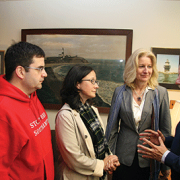|
UUP advocates had a major challenge to begin with. It came in the form of $152 million in additional budget cuts to SUNY and the proposed so-called Public Higher Education Empowerment and Innovation Act (PHEEIA). Then the governor introduced a furlough plan affecting most UUP members. The furlough was part of a weekly budget extender bill in early May that would keep state government operating in lieu of a new state budget. Faced with the specter of a state government shutdown if they failed to act, the Legislature reluctantly approved the bill and the furloughs. Within hours of the bill’s passage, UUP moved to stop the furloughs. The union—along with PEF, CSEA and Professional Staff Congress/CUNY—filed a lawsuit May 11 in U.S. District Court in Albany charging the furloughs were unconstitutional because they violate the article barring states from passing legislation that impairs contract obligations. UUP’s lawsuit included a temporary restraining order to block the furloughs. Little more than 24 hours later, the judge granted the restraining order, preventing the furloughs from going forward pending a final ruling on the lawsuit. Delegates to UUP’s Spring Delegate Assembly cheered when UUP President Phillip Smith held up a copy of the May 13 edition of the Albany Times Union that bore the headline, “100,000 to stay on the job.” “The fact that the judge ruled for the temporary restraining order so quickly is a good sign for us,” Smith told the delegates, reflecting optimism that UUP would prevail in court. That final ruling had not been made as The Voice went to press. Smith pledged that whatever happens, the union would take no action that would give the governor or the SUNY chancellor control of their contract. “Any plan that doesn’t meet our needs will be rejected. If it does meet our needs, it will go to the full membership for ratification,” Smith vowed. Most of UUP’s efforts to protect its members and SUNY took place not in the judicial arena, but in the legislative one. Members flocked to Albany for a series of advocacy days throughout March, April and May, meeting with state lawmakers to express their concerns and to seek their support. “I don’t know how SUNY can take another $152 million cut,” Outreach Committee Co-chair Glenn McNitt of New Paltz told Sen. Kemp Hannon (R-Garden City). “It would demolish it.” Abe Gerecht of Brooklyn HSC stressed the importance of funding SUNY when he told Assemblywoman Linda Rosenthal (D-Manhattan), “Education is a necessity, not an expense.” Lawmakers were told the prior budget cuts had already taken their toll on SUNY in the form of fewer course offerings, crowded classrooms and delayed graduations. “Campuses have come to the point where we have 150 students in an English class,” Oneonta Chapter President William Simons told Assemblywoman Barbara Clark (D-Queens Village). Clark also heard UUP’s appeal to save the New York State Theatre Institute, which is in danger of losing its state funding. “The theater institute is in peril,” warned Linda O’Malley of NYSTI. “We’re primarily an educational institution. Arts education is vitally important.” UUP advocates also continued waging the fight against PHEEIA, even challenging one of its chief backers, Assemblyman Mark Schroeder (D-Buffalo). UUP Vice President for Academics Frederick Floss responded to Schroeder’s claim that opposing the bill hinders job growth in western New York. “UUP is not hindering job growth,” Floss said. “This bill says you’re going to privatize SUNY and take away all your (the Legislature’s) oversight power.” PHEEIA figured prominently in UUP’s fight against the sudden decision to close Stony Brook’s Southampton campus. Just days after the Stony Brook administration announced the controversial closure, UUP’s Stony Brook Chapter forged a coalition with Southampton students. The result: Nearly 100 students joined with UUP advocates to meet with lawmakers on the issue. The UUP advocates served as mentors for the students, providing them guidance on advocacy prior to their visits. Stony Brook Chapter President Arthur Shertzer asserted that if PHEEIA passed—removing legislative oversight over SUNY—more such unilateral closures could occur. “What’s to stop SUNY from closing other schools?” Shertzer asked during a meeting with state Assemblyman Fred Thiele (I-Bridgehampton). “The chancellor and the SUNY Board of Trustees want to run SUNY without the Legislature.” In another cooperative advocacy effort with students, about 30 UUP members enlisted the help of more than 100 students from SUNY’s Equal Opportunity Program (EOP) and Equal Opportunity Centers (EOC) to jointly urge lawmakers to fund the programs. “We’ve got to send the message that these programs are critical,” Darleyne Mayers of Farmingdale told Sen. Carl Marcellino (R-Oyster Bay). “We can’t allow state cuts to kill the academic and economic dreams of these students.” Farmingdale EOP student Patrice Glenn, a single mom, said she wouldn’t be studying to become a licensed practical nurse at Farmingdale without the EOP. The EOP provides academic support and financial aid to low-income students who want to attend college. EOCs help prepare students for college or vocational training programs. But the programs face reductions as part of proposed state budget cuts to SUNY. Students like UAlbany’s Sheryl Berkow shared their success stories. “It’s sad to think that something like education, our dream, may be taken from us,” Berkow told an aide for Republican Assemblyman George Amedore Jr. (R-Amsterdam). — Donald Feldstein |
Warning: count(): Parameter must be an array or an object that implements Countable in /home/uuphos5/public_html/voicearchive/wp-includes/class-wp-comment-query.php on line 405


